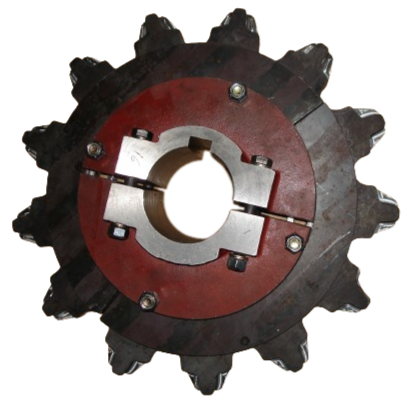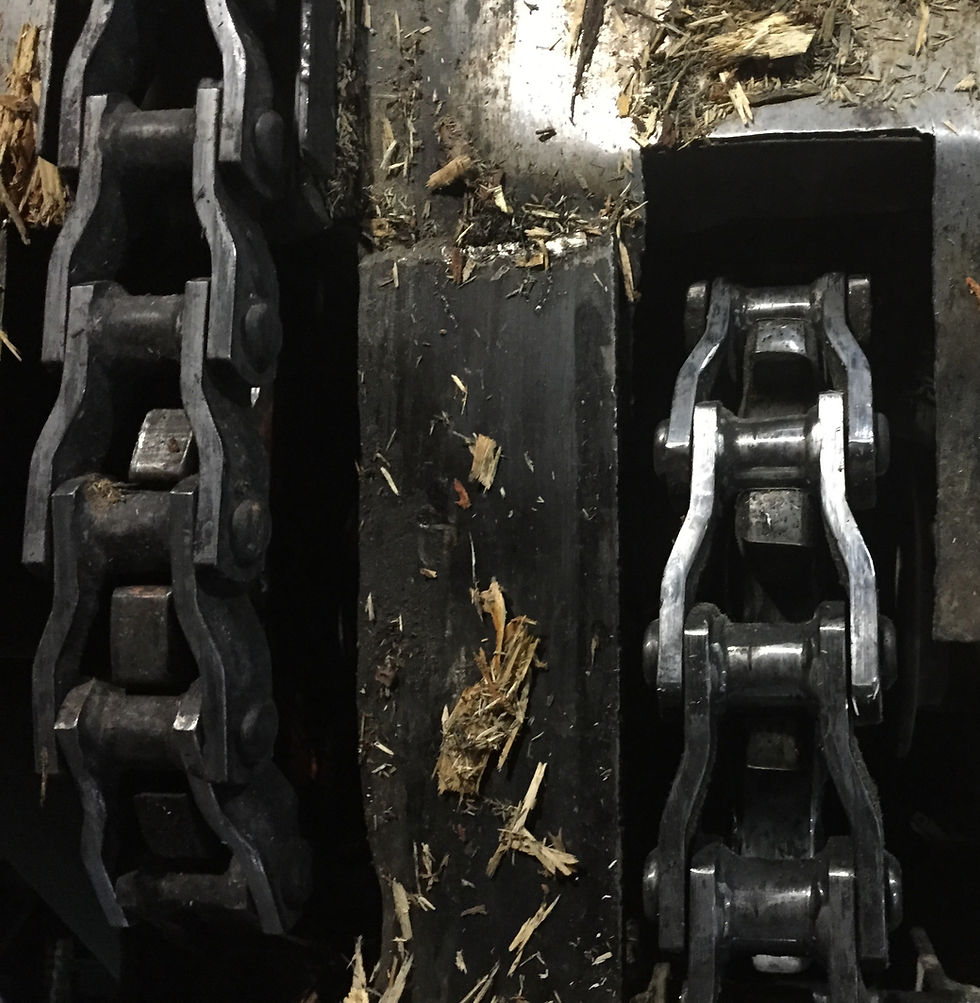Best Value: Long Link Mill Chain or Engineered Chain?
- Admin
- Apr 3, 2023
- 7 min read
Updated: Apr 27, 2023
There are two main types of industrial chain: round link chain and engineered chain.
While engineered chain for power transmission is standard across many industries, the lumber industry is one of a select few that uses round chain - and more specifically long link chain - in the manufacturing process.
Contents:
What is Engineered Chain?

The other type of chain common in the production of forestry products is engineered chain. This type of chain is made up of links that all follow the same orientation, allowing engineered chain to be driven by a sprocket with more teeth than a traditional round link chain. Every link in an engineered chain lays flat, providing more surface exposure and evenly distributing wear across the whole chain.
What is Long Link Mill Chain?
The international standard for long link chain restricts the maximum length of the link to eight times the diameter of the material used, and the overall link width to be less than or equal to four times the diameter of the link material. These dimensions provide enough space within the link to allow these chains to accommodate sprocket teeth, making long link chain ideal for use in lumber mills.

What is Long Link Mill Chain Used For?
Long link chain is used throughout the international forestry industry for the transference of materials through manufacturing processes and in and out of storage vessels. It is used to create plywood, OSB, and pulp and paper products, as well as in lumber manufacturing.
This traditional classification of chain is created by forming steel rod into links and welding the two ends together to form a solid structure. The result of this process is a chain with interlocking links that form an alternating pattern, with the orientation of successive links switching between lying flat and on edge.
Because links occur with consistent frequency and orientation, this type of chain can be pulled with a sprocket to convey material from one place to another.
In manufacturing, long link chains are often fitted with flights, which allow the chain to pull material through a conveyor channel.
Generally, long link chain is used in mills for “drag conveyors”, where a chain rides along the bottom of the channel and drags bulk waste materials with it. This is also the same application drum sprockets are used for, but long link chain has an advantage in certain applications due to its small size and flexibility.
Long Link Mill Chain Sprockets
There are two main types of sprockets used with long link chain. Both styles of sprocket interlock with every second chain link.
With the first type, the teeth of the sprocket go inside the links of the chain, catching the horizontal links, with the vertical chain links falling in between the teeth. Each tooth has cutouts that follow the profile of interlocked chain links.
The second type of sprocket works by catching the outside of the chain link in specialized grooves in the teeth. The horizontal chain links interlock with the sprocket tooth, while the vertical links fall into the center groove of the sprocket.
Why Use Long Link Mill Chain Over Engineered Chain
The main benefit of long link chain is the price. Long link chain is significantly cheaper than engineered chain based for low chain load requirements. It can be manufactured with standard welding tools and commonly found materials, and is available at most industrial chain suppliers.
Long link mill chain is commonly used in legacy equipment, therefore changing over to engineered chain could be cost prohibitive. As a result, many systems still use long link chain sprockets to drive their conveyors.
Another advantage to long link chain is that it does not require lubrication. This can come in handy for transporting final products that would be damaged by exposure to lubricants. Plywood sheets are sometimes transported using long link chain conveyors for this reason, as lubricants can stain the wood.
Long link mill chain is also a lightweight product. Engineered chain is a very compact and robust product, but it is much heavier than long link chain when comparing chains of the same length.
Disadvantages of Long Link Mill Chain
While long link chain is widely available for a fraction of the cost of engineered chain, it does pose some challenges to operators.
Each link of the chain is composed of a continuous loop of steel rod, but each shares the same weak point where the two ends are welded together. This is the most common failure point for all round link chains, and regularly inspecting these welds for weakness is impractical.
This type of chain has a level of flexibility not found in engineered chain, providing opportunity for the chain to twist. This is a common issue upon initial installation, and the first day or two after installing a new chain requires diligent oversight to correct the inevitable kinks that occur. If these kinks are not detected immediately, the twisted knot of chain can make its way to the sprocket driving the system, resulting in severe damage to both the sprocket and the new chain.
However, the main issue with long link mill chain occurs as the product ages. All chains are prone to slight stretching, but it causes a much more significant issue with round link chains. Because the driving sprocket operates in a vertical orientation, any slack in the chain will result in a slight twisting force that can cause the chain to easily slip off the sprocket.
Twisting can also cause the flights to skew slightly to one side, allowing smaller material such as sawdust and wood chips to slip underneath and pass to the next flight, causing uneven material distribution throughout the system.
Because of this, long link mill chain requires a dedicated tensioning mechanism such as an automated or manual mechanical take up, or an airbag system to remove slack from the line. This is typically a requirement for all chains, however it’s of greater importance with long link chain because of its propensity to stretch.
In addition to this, long link chain is louder than engineered chain, where the limited plane of motion and addition of rollers mitigate the clamour produced by the system.
The 5 Advantages of an Engineered Chain
1. Ease of installation and setup

Engineered chain has a square profile, with short sidebars, with rollers, pins and/or barrels. There is no wrong way to install an engineered chain with straight sidebars, however if the sidebars are offset there are two ways to install the chain, and its installation direction is application dependent.
You can greatly reduce chain wear by installing engineered chain with offset sidebars fat-end forward. Many manufacturers don’t pay close attention to this, especially when installing chain attachments such as wings, but will orient chains fat-end-forward upon request.
Installing the chain closed-end (narrow-end) first will decrease the lifespan of the chain by exerting rotational force on the link pin when the sprocket rotates, instead of allowing the chain link to rotate freely on its pin.
However, this narrow-side-first chain orientation causes much less wear on sprockets. See this article for more information about chain orientation and its effect on component wear.
2. Increased resilience without recurring point of weakness
Long link chain links all share the same point of weakness: the weld. Each link is formed of steel bar, bent into shape and welded into a continuous loop. If round link chain breaks, it’s usually at the weld.
Engineered chain is made using a series of sidebars, barrels and pins, with construction generally involving welding, although some chains can be made without welding. With lubricated bushings and dedicated hinge points, engineered chain links don’t share a common fault point, distributing wear evenly across the chain and greatly increasing working load limits, longevity, and the number of applications they can be used in.
3. Modular, easy to maintain
If a link does fail, engineered chain is modular. Simply remove the rivet or pin and replace the link with a new one. This simple process can be done with minimal equipment and results in a chain every bit as strong as before. Some types of chain rollers self-lubricate and all are very resistant to wear, especially when paired with a hardened steel pin or barrel.
4. Won’t derail as easily if chain stretches
Traditional long link chain stretches as the metal wears down and links elongate over time. To counteract this, long link chain is often paired with a tensioning mechanism to remove the slack. This is adjusted over time to ensure the chain tracks properly.
Engineered chain stretches as well due to pin and bushing wear, but the flat profile of the chain prevents the chain from twisting as it engages with the sprocket. As a result, engineered chain is less likely to derail as it stretches over time.
5. Useable with wider sprocket teeth
Engineered chain has a wider load bearing surface, allowing for more effective power transmission.
Round link chain of similar width of similar width to an engineered chain would twist due to the size and orientation of the links, making this type of setup impossible. As a rule of thumb, round link chains intended for use with sprockets feature elongated links with minimal horizontal movement to best align with the sprocket.
The Takeaway
Engineered chain offers significant benefits over long link mill chain when it comes to maintenance, application uses and working loads. The break-in period of engineered chain requires less supervision and adjustment, and its modular nature means maintenance operators can simply replace any problematic links.
DROP Sprockets manufactures sprockets in every size, including both long link chain sprockets and engineered chain sprockets. Give us a call today and we’ll get back to you with a quote in less than an hour.
Our sprockets – including made-to-order – ship out in an average of four days from our facilities in Canada & USA, with same-day rush capacity available for emergencies.









Comments